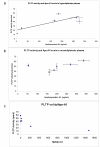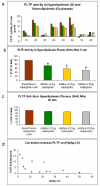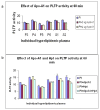Haptoglobin inhibits phospholipid transfer protein activity in hyperlipidemic human plasma
- PMID: 19627602
- PMCID: PMC2729738
- DOI: 10.1186/1476-511X-8-27
Haptoglobin inhibits phospholipid transfer protein activity in hyperlipidemic human plasma
Abstract
Background: Haptoglobin is a plasma protein that scavenges haemoglobin during haemolysis. Phospholipid Transfer Protein (PLTP) transfers lipids from Low Density Lipoproteins (LDL) to High Density Lipoproteins (HDL). PLTP is involved in the pathogenesis of atherosclerosis which causes coronary artery disease, the leading cause of death in North America. It has been shown that Apolipoprotein-A1 (Apo-A1) binds and regulates PLTP activity. Haptoglobin can also bind to Apo-A1, affecting the ability of Apo-A1 to induce enzymatic activities. Thus we hypothesize that haptoglobin inhibits PLTP activity. This work tested the effect of Haptoglobin and Apo-A1 addition on PLTP activity in human plasma samples. The results will contribute to our understanding of the role of haptoglobin on modulating reverse cholesterol transport.
Results: We analyzed the PLTP activity and Apo-A1 and Haptoglobin content in six hyperlipidemic and six normolipidemic plasmas. We found that Apo-A1 levels are proportional to PLTP activity in hyperlipidemic (R2 = 0.66, p < 0.05) but not in normolipidemic human plasma. Haptoglobin levels and PLTP activity are inversely proportional in hyperlipidemic plasmas (R2 = 0.57, p > 0.05). When the PLTP activity was graphed versus the Hp/Apo-A1 ratio in hyperlipidemic plasma there was a significant correlation (R2 = 0.69, p < 0.05) suggesting that PLTP activity is affected by the combined effect of Apo-A1 and haptoglobin. When haptoglobin was added to individual hyperlipidemic plasma samples there was a dose dependent decrease in PLTP activity. In these samples we also found a negative correlation (-0.59, p < 0.05) between PLTP activity and Hp/Apo-A1. When we added an amount of haptoglobin equivalent to 100% of the basal levels, we found a 64 +/- 23% decrease (p < 0.05) in PLTP activity compared to basal PLTP activity. We tested the hypothesis that additional Apo-A1 would induce PLTP activity. Interestingly we found a dose dependent decrease in PLTP activity upon Apo-A1 addition. When both Apo-A1 and Hpt were added to the plasma samples there was no further reduction in PLTP activity suggesting that they act through a common pathway.
Conclusion: These findings suggest an inhibitory effect of Haptoglobin over PLTP activity in hyperlipidemic plasma that may contribute to the regulation of reverse cholesterol transport.
Figures





Similar articles
-
Differences in human phospholipid transfer protein activity following incubation of Fungizone compared to lipid-based Amphotericin-B formulations in normolipidemic and hyperlipidemic plasma.Drug Dev Ind Pharm. 2009 Sep;35(9):1139-46. doi: 10.1080/03639040902824852. Drug Dev Ind Pharm. 2009. PMID: 19381990
-
Remodeling of apolipoprotein E-containing spherical reconstituted high density lipoproteins by phospholipid transfer protein.J Lipid Res. 2008 Jan;49(1):115-26. doi: 10.1194/jlr.M700220-JLR200. Epub 2007 Oct 5. J Lipid Res. 2008. PMID: 17921435
-
Mass concentration of plasma phospholipid transfer protein in normolipidemic, type IIa hyperlipidemic, type IIb hyperlipidemic, and non-insulin-dependent diabetic subjects as measured by a specific ELISA.Arterioscler Thromb Vasc Biol. 1999 Feb;19(2):266-75. doi: 10.1161/01.atv.19.2.266. Arterioscler Thromb Vasc Biol. 1999. PMID: 9974406
-
Roles of plasma lipid transfer proteins in reverse cholesterol transport.Front Biosci. 2001 Mar 1;6:D366-87. doi: 10.2741/yamashita. Front Biosci. 2001. PMID: 11229884 Review.
-
Plasma lipid transfer proteins: The role of PLTP and CETP in atherogenesis.Adv Clin Exp Med. 2018 Mar;27(3):429-436. doi: 10.17219/acem/67968. Adv Clin Exp Med. 2018. PMID: 29558025 Review.
Cited by
-
Acute-phase reactants and a supplemental diagnostic aid for Kawasaki disease.Pediatr Cardiol. 2010 Nov;31(8):1209-13. doi: 10.1007/s00246-010-9801-y. Epub 2010 Oct 19. Pediatr Cardiol. 2010. PMID: 20957478 Free PMC article.
-
Pharmacogenomic interaction between the Haptoglobin genotype and vitamin E on atherosclerotic plaque progression and stability.Atherosclerosis. 2015 Mar;239(1):232-9. doi: 10.1016/j.atherosclerosis.2015.01.008. Epub 2015 Jan 14. Atherosclerosis. 2015. PMID: 25618031 Free PMC article.
-
Prevalence of and risk factors for gallstones in Uighur and Han Chinese.World J Gastroenterol. 2014 Oct 28;20(40):14942-9. doi: 10.3748/wjg.v20.i40.14942. World J Gastroenterol. 2014. PMID: 25356055 Free PMC article.
-
The innate immune response to coxsackievirus B3 predicts progression to cardiovascular disease and heart failure in male mice.Biol Sex Differ. 2011 Feb 21;2:2. doi: 10.1186/2042-6410-2-2. Biol Sex Differ. 2011. PMID: 21338512 Free PMC article.
-
Identification of fibrin clot-bound plasma proteins.PLoS One. 2012;7(8):e41966. doi: 10.1371/journal.pone.0041966. Epub 2012 Aug 3. PLoS One. 2012. PMID: 22870270 Free PMC article.
References
-
- Polticelli F, Bocedi A, Minervini G, Ascenzi P. Human haptoglobin structure and function–a molecular modelling study. FEBS J. 2008;275:5648–56. - PubMed
Publication types
MeSH terms
Substances
LinkOut - more resources
Full Text Sources
Research Materials
Miscellaneous

